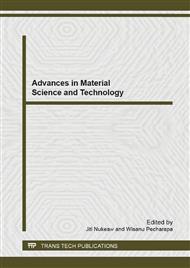[1]
S.A. Van Slyke, C.H. Chen, C.W. Tang, Appl. Phys. Lett. 69 (1996) p.2160.
Google Scholar
[2]
N.R. Armstrong, D.M. Wang, W. Alloway, D. Placencia, E. Ratcliff, M.Brumbach, Macromol. Rapid Commun. 30 (2009) p.717.
DOI: 10.1002/marc.200990018
Google Scholar
[3]
Z. Bao, A.J. Lovinger, A. Dodabalapur, Appl. Phys. Lett. 69 (1996)p.3066.
Google Scholar
[4]
M.-M. Ling, Z. Bao, Org. Electron. 7 (2006)p.568.
Google Scholar
[5]
S.Senthilarasu, S.Velumani, R. Sathyamoorthy, A. Subbarayan, J.A. Ascencio, G.Canizal, P.J. Sebastian, J.A. Chavez, R.Perez, Appl.Phys. A 77. (2003) pp.383-389.
DOI: 10.1007/s00339-003-2184-7
Google Scholar
[6]
K.Flatz, M.Grobosch, M.Knupfer, Appl.Phys. A 90, (2008)pp.243-246.
Google Scholar
[7]
M.F. Craciun, S. Rogge, and A.F. Morpurgo, ,J. Am. Chem. Soc. 127, (2005) p.12210
Google Scholar
[8]
M.F. Craciun, S. Rogge, M.J.L. den Boer, S. Margadonna, K. Prassides, Y. Iwasa and A.F. Morpurgo, "Electronic transport through electron-doped metal phthalocyanine materials," Adv. Mater. 18, (2006)pp.320-324.
DOI: 10.1002/adma.200501268
Google Scholar
[9]
L. Gaffo, M.R. Cordeiro, A.R. Freitas, W.C. Moreira, E.M. Girotto, V. Zucolotto, "The effects of temperature on the molecular orientation of zinc phthalocyanine films," J Mater Sci. 45, (2010) pp.1366-1370.
DOI: 10.1007/s10853-009-4094-3
Google Scholar
[10]
S. Senthilarasu, Y.B. Hahn, Soo-Hyoung Lee, "Nano structure formation in vacuum evaporated zinc phthalocyanine(ZnPc) thin films," J Mater Sci. 19, (2008) pp.482-486.
DOI: 10.1007/s10854-007-9368-4
Google Scholar
[11]
A.B.P. Lever, Adv. Org. Chem. Radiochem. 7 (1965) p.27.
Google Scholar
[12]
K.A. Nguyen, R. Pachter, J. Chem. Phys. 114 (2001) p.10757.
Google Scholar
[13]
A. Rosa, G. Ricciardi, E.J. Baerends, S.J.A. van Gisbergen, J.Phys.Chem.A105(2001)p.3311.
Google Scholar
[14]
D.A. Shirley, Phys. Rev. B 5, (1972)pp.4709-4714
Google Scholar
[15]
Y. Niwa, H. Kobayashi, T. Tsuchiya, J. Chem. Phys. 60 (1974) 799
Google Scholar
[16]
G. Dufour, C. Poncey, F. Rochet, H. Roulet, M. Sacchi, M.D. Santis, M.D. Crescenzi, Surf. Sci. 319 (1994)251.
Google Scholar
[17]
H. Peisert, M. Knupfer, J. Fink, Surf. Sci. 515 (2002)p.491.
Google Scholar
[18]
Z.Liu, X.Zhang, Y.Zhang,J.Jiang, Spectrochimica Acta Part A 67 (2007) pp.1232-1246.
Google Scholar
[19]
M.Grobosch, C. Schmidt, R. Kraus, M. Knupfer, Organic Electronics 11(2010) pp.1438-1488.
Google Scholar
[20]
H.Peisert, M.Knupfer, J.Fink,Surface Science 515 (2002) pp.491-498.
Google Scholar
[21]
T.Schwieger, H.Peisert, M.S. Golden, M.Knupfer, J.Fink,Phys.Rev. B66 (2002),p.155207.
Google Scholar
[22]
F.Cantao, W.Melo,L.Oliveira, A.Passos, A.Silva, Quim.Nova 3 (2010)
Google Scholar


